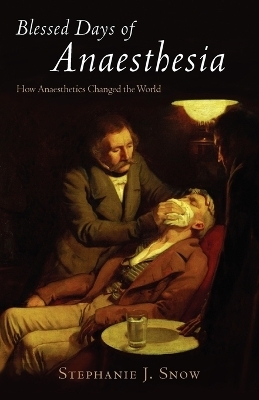
Blessed Days of Anaesthesia
How anaesthetics changed the world
Seiten
2009
Oxford University Press (Verlag)
978-0-19-280589-8 (ISBN)
Oxford University Press (Verlag)
978-0-19-280589-8 (ISBN)
Among the great discoveries of the nineteenth century, few offer a more fascinating insight into Victorian society than the new science of anaesthesia. This vivid and engaging history reveals how the worlds of Victorian medics, moralists, and clergymen were plunged into turmoil and debate by the discovery and introduction of anaesthetic medicine.
Among all the great discoveries and inventions of the nineteenth century, few offer us a more fascinating insight into Victorian society than the discovery of anaesthesia. Now considered to be one of the greatest inventions for humanity since the printing press, anaesthesia offered pain-free operations, childbirth with reduced suffering, and instant access to the world beyond consciousness. And yet, upon its introduction, Victorian medics, moralists, clergymen, and scientists, were plunged into turmoil.
This vivid and engaging account of the early days of anaesthesia unravels some key moments in medical history: from Humphry Davy's early experiments with nitrous oxide and the dramas that drove the discovery of ether anaesthesia in America, to the outrage provoked by Queen Victoria's use of chloroform during the birth of Prince Leopold. And there are grisly ones too: frequent deaths, and even notorious murders.
Interweaved throughout the story, a fascinating social change is revealed. For anaesthesia caused the Victorians to rethink concepts of pain, sexuality, and the links between mind and body. From this turmoil, a profound change in attitudes began to be realised, as the view that physical suffering could, and should, be prevented permeated through society, most tellingly at first in prisons and schools where pain was used as a method of social control. In this way, the discovery of anaesthesia left not only a medical and scientific legacy that changed the world, but a compassionate one too.
Among all the great discoveries and inventions of the nineteenth century, few offer us a more fascinating insight into Victorian society than the discovery of anaesthesia. Now considered to be one of the greatest inventions for humanity since the printing press, anaesthesia offered pain-free operations, childbirth with reduced suffering, and instant access to the world beyond consciousness. And yet, upon its introduction, Victorian medics, moralists, clergymen, and scientists, were plunged into turmoil.
This vivid and engaging account of the early days of anaesthesia unravels some key moments in medical history: from Humphry Davy's early experiments with nitrous oxide and the dramas that drove the discovery of ether anaesthesia in America, to the outrage provoked by Queen Victoria's use of chloroform during the birth of Prince Leopold. And there are grisly ones too: frequent deaths, and even notorious murders.
Interweaved throughout the story, a fascinating social change is revealed. For anaesthesia caused the Victorians to rethink concepts of pain, sexuality, and the links between mind and body. From this turmoil, a profound change in attitudes began to be realised, as the view that physical suffering could, and should, be prevented permeated through society, most tellingly at first in prisons and schools where pain was used as a method of social control. In this way, the discovery of anaesthesia left not only a medical and scientific legacy that changed the world, but a compassionate one too.
Stephanie Snow is a Research Associate at the Centre for the History of Science, Technology and Medicine at the University of Manchester. She wrote her PhD thesis on the life and work of John Snow (1813-1858), and is the author of Operations Without Pain: The practice and science of anaesthesia in Victorian Britain (Palgrave Macmillan, 2006).
1. Introduction ; 2. Discoveries ; 3. Anaesthesia in Action ; 4. Women, Sex and Suffering ; 5. On Battlefields ; 6. The Dark Side of Chloroform ; 7. Changed Understandings of Pain ; 8. Into the Twentieth Century and Beyond ; Endnotes ; Further reading
| Erscheint lt. Verlag | 10.9.2009 |
|---|---|
| Zusatzinfo | 16 halftone illustrations |
| Verlagsort | Oxford |
| Sprache | englisch |
| Maße | 128 x 196 mm |
| Gewicht | 181 g |
| Themenwelt | Sachbuch/Ratgeber ► Natur / Technik |
| Geschichte ► Allgemeine Geschichte ► Neuzeit (bis 1918) | |
| Geisteswissenschaften ► Geschichte ► Regional- / Ländergeschichte | |
| Medizin / Pharmazie ► Medizinische Fachgebiete ► Anästhesie | |
| Studium ► Querschnittsbereiche ► Geschichte / Ethik der Medizin | |
| Naturwissenschaften | |
| Technik ► Elektrotechnik / Energietechnik | |
| ISBN-10 | 0-19-280589-4 / 0192805894 |
| ISBN-13 | 978-0-19-280589-8 / 9780192805898 |
| Zustand | Neuware |
| Haben Sie eine Frage zum Produkt? |
Mehr entdecken
aus dem Bereich
aus dem Bereich
Europa 1848/49 und der Kampf für eine neue Welt
Buch | Hardcover (2023)
DVA (Verlag)
48,00 €
Giordano Bruno - ein ketzerisches Leben
Buch | Hardcover (2024)
C.H.Beck (Verlag)
29,90 €


